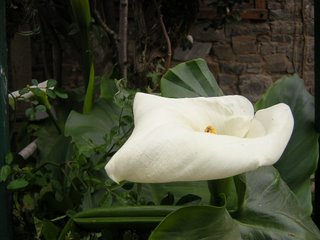
Magnolia. (Magnoliaceae).
A genus of 80 species of hardy evergreen and deciduous flowering trees and shrubs. It contains some of the most spectacular speciment trees and shrubs.
The magnolia shown in this picture may be Magnolia sieboldii, syn. M. parviflora, found in Japan or Korea. Height and spread 10-15 feet. The pendent, bowl-shaped flowers, 3in across, are white with conspicuous claret stamens. OR it could be
Magnolia x soulangiana. Height 10-15 ft; spread 10-18ft. White, chalice-shaped flowers, 5-6in across and stained rose-purple at the base, open in April before the leaves unfurl. Of Japanese origin.

Jasminum. Jasmine (Oleaceae).
A genus of 300 species of tender and hardy, deciduous and evergreen shrubs and climbers. They are suitable as ground cover on rock gardens , for training against walls or fences or for twining over arbours, trellises and pergolas.
Jasmine flowers are tubular, opening out salviform; they are usually borne in terminal and axillary clusters, sometimes forming panicles. Some species are strongly fragrant. The leaves are opposite and in most cases, pinnate.
These varieties are yellow – J. mesnyi, syn. J. primulinum (primrose jasmine). China. Height up to 10 ft and J. nudiflorum (winter-flowering jasmine). China. Height up to 10 ft.
This picture is probably of J. parkeri (N.W. India). Height 8-12 inches (sic). A hardy, dense, hummock-forming evergreen shrub with pinnate leaves. Yellow.

Zantedeschia. (Araceae).
A genus of eight or nine species of rhizomatous, perennial, half-hardy and tender greenhouse(!) plants. The flowers are borne on a spadix at the end of a long stem and surrounded by a large spathe. Forms of Zantedeschia aethiopica may be grown out of doors in mild districts in UK.
This picture is that of an Arum Lily (Zantedeschia aethiopica). From South Africa. A deciduous species with mid to deep green, slightly glossy, arrow-shaped leaves. White spathes, 5-9inches long, surrounding a conspicuous yellow spadix are borne from March to June.

Wisteria (Leguminosae).
A genus of ten species of hardy deciduous climbing shrubs. They are among the most beautiful of all climbing plants and are used to decorate walls, fences, arches, pergolas and trees.
The flower could be either : (1) Wisteria sinensis (Chinese wisteria). Height up to 100ft. This large species is the finest and most popular of the wisterias. The dark to mid-green leaves consist of up to eleven leaflets which makes the species easily distinguishable from (2) Wisteria floribunda. Dense, 8 to 12 inch long racemes of fragrant mauve flowers are freely produced. Wisteria sinensis ’Alba’ has white flowers; Wisteria sinensis ‘Plena’ has double mauve flowers.

This is a species of camellia.









No comments:
Post a Comment